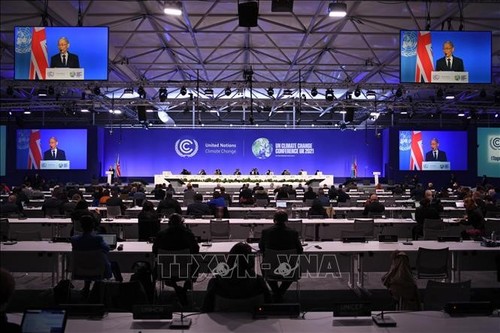 COP26 opening ceremony in Glasgow, Scotland (photo: VNA) COP26 opening ceremony in Glasgow, Scotland (photo: VNA) |
COP26 takes place with global climate change nearing a point of no return. The conference’s opening report said the average sea level has risen 2.3m over the last 3 decades because warmer temperatures have caused polar ice sheets to melt. Meanwhile record levels of greenhouse gas emissions have been reported.
Prior to the summit, UN Secretary General Antonio Guterres said the current climate situation is "a one-way ticket to disaster". COP26 is expected to set goals that will decide whether the world survives the current crisis.
Positive signs
A day before the summit, the G20 Summit reached a consensus on the effort to curb global warming. For the first time, G20 leaders agreed on a goal of keeping global warming to less than 1.5°C above pre-industrial levels for the next decade. This commitment by the influential G20 is seen as an encouragement to the leaders attending COP26.
Another big encouragement for COP26 and the fight against climate change is the return of the US to the effort. Since taking office last January, President Joe Biden has brought the US back to a number of international agreements, including the 2015 Paris Agreement, and has pledged that by 2025 the US will reduce its net greenhouse gas emissions to 50-52 percent of the 2005 level. He reconfirmed this commitment Monday on the first day of COP26.
India, one of the world’s biggest greenhouse gas producers, has promised to cut its emissions to net zero by 2070, becoming the last big carbon dioxide emitter to set a net zero target. Before that China announced a net zero target by 2060 and the US and the EU by 2050.
A lot of challenges will demand a lot of efforts
COP26 promises progress but the challenges are daunting. The US leadership is not guaranteed. President Biden’s plan to invest 555 billion USD in clean energy has not yet been approved by Congress. A 150-billion-USD program to reduce greenhouse gas emissions in the electricity sector has already been removed from the budget bill.
It’s more than possible that countries cannot or will not fulfill their commitments. For one thing, resources spent on responding to the COVID-19 pandemic have shrunk resources available for responding to climate change. This explains why many of the leaders attending COP26 have emphasized the importance of prioritizing resources to fight climate change.
Vietnamese Prime Minister Pham Minh Chinh, in his keynote speech at the opening of COP26, said responding to climate change must be the top priority of every development policy, and the top ethical standard of every sector, business, and individual. He called on countries to accept their shared responsibility to make the strongest commitment to reduce greenhouse emissions compatible with their capacity, adding that there should be fairness and justice in dealing with climate change.